The effects of microbial biodiversity on ecosystem function in response to climate change
Introduction
By Isaac Johnson
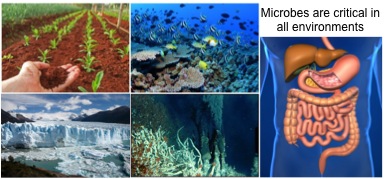
Throughout the world, microbes in various ecosystems perform a vast array of different functions that are crucial to the maintenance of the respective environments. For example, in some nutrient-poor ecosystems, nitrogen-fixing bacteria and mycorrhizal fungi are responsible for providing the plants up to 80% of their total nitrogen, and 75% of their total phosphorus annually. [1] Further, our own bodies rely on microbial symbionts in order to provide us with necessary nutrients, direct our immune systems, and stabilize our gut microbiome with antimicrobial activities. [2] Surveys of any global ecosystem will demonstrate the importance of the microbiome on the functionality of that ecosystem.
Currently, warming due to anthropogenic activities has occurred in every single global region over the past century, with current temperatures and CO2 levels that would have been considered extreme in the mid-twentieth century. [3] This atmospheric accumulation of CO2 has driven the current global temperatures upwards, and forced ecosystems to function at evolutionarily non-optimal temperatures. However, microbes are able to mitigate some of these effects through various mechanisms. For example, under extreme temperature conditions, endoliths provided a temperature buffer of between 1.7°C and 4.8°C, and, when present, prevented mass mussel mortality in a 2018 heatwave near the coast of the English Channel. [4]
While microbes can serve as mitigators of global climate change, they can also serve to accelerate the aforementioned changes in the biosphere. Microbial respiration is a major contributor to global carbon levels due to the ability of microbes to decompose organic matter and release CO2 as a waste product. [5] Additionally, there is an entire group of microbes called methanogens who produce methane (CH4) as a product of their metabolism. [6] While this production of methane could be used as a potential fuel source through anthropogenic manufacturing, the natural metabolism of methane is dangerous to climate change, as methane has a global warming potential roughly 25 times greater than CO2. [7]
In addition to playing a crucial role in natural ecosystems, agricultural ecosystems are equally as reliant on microbial interactions. The agricultural industry currently produces about 47% of total methane emissions and 58% of total nitrous oxide emissions. [8] The massive effects of this industry are only going to increase as the global population is expected to increase by ⅓ to 10 billion in the year 2050, forcing our agricultural production to increase by 60% to meet the demand for food to sustain a population of that size. [9] This example demonstrates the profound need for more sustainable anthropogenic practices, as well as a better understanding of microbes to promote healthier ecosystem functioning.
We have already seen that microbes have various crucial roles in different ecosystems, however, microbial biodiversity and not just microbial presence is a key component of maintaining healthy ecosystem functioning. Due to the wide range of different metabolism as well as the numerous environmental niches for microbes, microbial biodiversity is critical in the maintenance of a healthy ecosystem, and is easily accomplished due to seemingly redundant “cryptic” species of microbes. [10] Further, under realistic scenarios of climate change, this seeming redundancy has been shown to be functionally unique, as interspecific complementation increased under thermal stress. [11] Overall, this shows how the large amounts of biodiversity observed within the microbial world could prove important in maintaining ecosystem functioning with increased climate change.
Given the importance of diverse microbial interactions on ecosystem stability, microbial communities could have far reaching effects on climate change in ecosystems across the globe. It has been forecasted that under scenarios of climate change, there will be directional selection for warm-tolerant organisms and rapid migration events, all of which will contribute to widespread losses in biodiversity. [12] The following examination of projected climate effects and diverse microbial communities will allow us to understand the problems and strategies for mitigation of the current situation.
Microbial Biodiversity in Natural Ecosystems

Overall biodiversity is often a key consideration in the maintenance of a healthy ecosystem, however, microbial biodiversity takes this notion to the extreme. In plants and animals, there is typically a positive but decreasing relationship between biodiversity and ecosystem functioning (BEF). [13] The decreasing slope of this relationship is due to the organismal functional redundancy that exists in these ecosystems (certain organisms providing the same service to the ecosystem). However, in terms of microbes, the BEF relationship reveals that with decreased microbial diversity, there are decreases in both general and specialized functioning in every examined scenario. [13] This serves to indicate that there is limited functional redundancy in microbial communities, and there are numerous critical niches filled by vastly different species. Overall, the array of niches filled by specific microbes is unsurprising given that bacteria is the oldest as well as the most diverse domain of life. [14] Understanding what these niches are and how they are filled in an ecosystem is critical to understanding the importance of diverse microbial communities.
Microbes are able to metabolize numerous different substrates in order to generate energy. One of the most important areas in which this metabolism occurs is through cyanobacterial autotrophy. Cyanobacteria and chloroplasts (which evolved as eukaryotic endosymbionts from cyanobacteria) are the only two sources of life that produce oxygen gas through the capture of solar radiation. [15] Given the reliance of a large percentage of organisms on oxygen in order to respire, as well as the fact that autotrophic primary production supports all life, this is a vital niche in our biosphere. However, autotrophic cyanobacteria are only the tip of the iceberg in terms of microbial respiration. Some lithotrophic microbes use inorganic electron donors to generate energy, while other microbes have the ability to ferment substrates, and others use combinations of multiple types of catabolism. [15] Overall, the ability of these diverse organisms to use different substrates to yield different products under variable environmental conditions is the reason why they are so vital to the stability of ecosystems. Furthermore, microbes not only have the ability to use variable substrates, they can also remove toxins from the environment. An example of this comes from petroleum, which can be used by over 79 different genera of bacteria that are capable of using petroleum (an environmental contaminant) as a substrate for metabolism. [16] These variable methods of catabolism exhibited by different species cycle various important minerals and nutrients and showcase the importance of microbes in numerous different niches.

In addition to diverse catabolism to cycle nutrients, one of the other key roles of microbes in an ecosystem is the diverse and specific symbiotic relationships formed with various different species of plants, animals, and other microbes. Recent research has found that symbiosis is the central driver of all evolution across the entire tree of life, demonstrating the profound importance of these interactions. [17] One of the most well-studied examples of this type of symbiosis is between legumes and nitrogen-fixing bacteria. A 2006 study showed that three out of four experimental species of legumes required the presence of nitrogen-fixing rhizobia in order to successfully grow in the presence of other plant species. [18] While many plants require similar symbiotic relationships in order for proper growth, numerous animal species are also reliant on diverse microbial symbionts in order for proper functioning. Similarly to humans, some ants have been shown to exist with various gut microbes that are able to influence the behavior of their host and provide nutrients in return. [19] This association between ants and their microbiota has also been shown to have evolved numerous times throughout the course of their evolutionary history showing the specificity of these interactions. [19] These examples are only a few of the many diverse symbiotic relationships that microbes form with different species. From these examples, it becomes clear that a wide array of specific interactions occur between microbes and other organisms, and that these interactions have evolved many times in tandem with one another, revealing another reason why wide microbial biodiversity is necessary to support a functioning organismal ecosystem.
Anthropogenic Ecosystems and Microbial Biodiversity
Agriculture
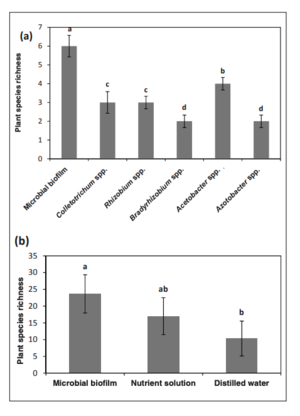
As mentioned previously, current agricultural practices contribute a large amount of greenhouse gasses and other pollutants into the environment, accelerating the increase of climate change and subsequent biodiversity loss worldwide. In 2015, the Environmental Protection Agency (EPA) estimated that 22.0 million tons of fertilizers were used for agricultural practices in the United States alone. [20] This influx of fertilizer results from an increased need for crop yields with a growing population, and a history of unsustainable practices, such as monoculture, depleting the nutrient-rich topsoil. However, despite the intention, long-term application of fertilizers can lead to groundwater contamination through nitrate formation. [21] This occurs due to the fact that inorganic nitrogen fertilization results in between 24-82% of the total nitrogen being lost through leaching or ammonia volatilization. [21] Given the ineffectiveness of our current practices, alternative methods for agriculture are needed as the current methods contaminate the surrounding environment and release large quantities of greenhouse gasses, furthering climate change. Additionally, with these increases in climate change, drought and heat waves are predicted to increase, posing an even greater risk to our struggling agricultural system. [22]
Microbes have been associated with plants through multiple communication systems through millions of years of evolution. [23] Given this interconnected evolution, various microbes have become extremely efficient in decomposition, controlling pathogens, reducing greenhouse gasses, and supporting entire ecosystems through recycling key nutrients. [23]
Given these key ecosystem responsibilities of diverse microbial communities, it is gravely concerning that modern agricultural practices are degrading the existing biodiversity. However, there are many innovative new techniques emerging aimed at the sustainable continuation of agricultural practices with a focus on restoring biodiversity to our depleted soils. One of these strategies is the application of fungal-bacterial biofilms (FBB). [24] When soil was treated with FBB compared to fungal and bacterial monocultures, significantly higher species richness was observed, higher yields, increased stress tolerance, as well as increased nitrogen fixation were observed. [24] These results, pictured on the right, demonstrate that harboring diverse microbial communities increases the overall production and richness of agricultural ecosystems that have been depleted of nutrients. This serves as a model for potential future remediation as our current practices continue to degrade the existing biodiversity in our soil globally.
Human Health
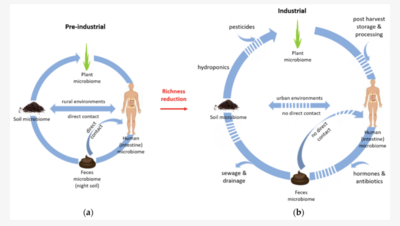
In addition to symbiotic interactions in agricultural ecosystems, microbial communities provide other various benefits to human health. Through a combination of genetic and environmental factors as well as disease and diet, the human microbiome contains thousands of bacterial species that are constantly developing and changing. [25]
These changes and the composition of the microbiome have a significant impact on the overall health and wellbeing of individuals. For example, there have been several studies that demonstrate correlations between exposure to diverse microbes and reduction in sickness, mortality, and increased overall health. One of these studies comes from a Taiwanese middle school, which observed that after placing six plants in the back of a classroom, there were less overall sick days and less disciplinary behavior from the group with plants as compared to a control group. [26] Another study found that there was a significant reduction in allergic diseases in children that were exposed to a wide range of natural microbes through such means as natural childbirth, breastfeeding, time spent outdoors, as well as diminished antibiotic use. [27] This furthers the idea that humans, similarly to plants, have undergone millions of years of coevolution with our microbiomes, and that a well-balanced microbiome emerges through ample levels of environmental exposure to diverse microbial communities. Additional studies have found similar results, such as a 2007 study that demonstrated an increase in the number of natural killer cells and expression of anticancer proteins in males after exposure to microbes through bathing in forests. [28] Overall, environmental microbe exposure and exposure to microbiomes of closely related animals has a significant effect on the human microbiome as well as human health. [29]
While the direct interaction of microbes can exert effects on human health, there are also indirect ways in which the diversity of microbial communities can affect human health. For example, it has been estimated that since 1800, around half of the total CO2 released by humans into the atmosphere has been absorbed by the ocean, the world's largest carbon sink. [30] However, this absorption of CO2 has led to the acidification of the ocean with a drop in pH from 8.2 to 8.1 which has exhibited large negative effects on the calcifying marine organisms such as coccolithophores. [31] This has led to decreases in yield from coral-associated fisheries as well as the production of farmed oysters in the Pacific Northwestern United States. [31] From these examinations, it becomes clear that microbial communities strongly influence human health both directly and indirectly, and that increased microbial biodiversity has various positive implications for humans.
Microbial Biodiversity Under Climate Change
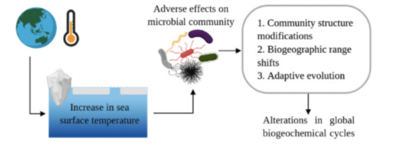
Under the current scenario of climate change, microbial communities will experience drastic changes in many of the vital processes mentioned previously. One of these processes is that of plant litter decomposition. A 2011 study demonstrated that with increased global temperatures, microbial litter decomposition in aquatic ecosystems will increase at the expense of declining detrivore decomposition. [32] While this will produce no changes in the overall amount of decomposition, the shift from detrivore decomposition to microbial-dominated decomposition will increase the CO2 production of these environments. [32] This is an example of how warming combines with a loss of biodiversity in order to impair the ideal functioning of microbial communities, and how more biodiversity is required in order to maintain proper ecosystem functioning with global warming. [11]
While the previous example showed an effect of warming on an aquatic ecosystem, the terrestrial soil ecosystems are predicted to experience some of the most drastic changes under increased warming scenarios. Additionally, soil contains roughly twice the amount of carbon that is present in Earth’s atmosphere demonstrating the profound importance of this ecosystem. [33] Similarly to the aquatic ecosystem mentioned previously, increased temperatures are predicted to increase the microbial decomposition of organic matter, which releases a higher amount of CO2 into the atmosphere. [34] Additionally, global warming will increase the amount of thawing permafrost in arctic regions, which will increase the amount of anaerobic methanogenesis. [34] As mentioned earlier, methanogenesis is a dangerous metabolic activity in our current climate change scenario, as methane production is more sinister in its ability to raise global temperatures than CO2.
The long-term effects of global warming on soil communities will undoubtedly serve to alter them in ways synonymous to the previously examined scenarios. Prolonged increased temperatures will serve to directionally select for thermophilic microbes, with short-term exposures selecting for thermotolerant microbes. [22] Most mesophilic microbes are subject to severe stress in response to high temperature conditions in soil, especially when this is combined with low water potentials. [22] This will therefore select for thermotolerant and thermophilic microbes. While this may not seem like a detrimental effect, as we have seen previously, microbes form complex communities that function optimally under naturally high levels of biodiversity, indicating that strong selection for thermotolerant microbes will likely drastically alter the functioning of these soil ecosystems and subsequent plant growth.
Strategies for Remediation and Biodiversity Restoration

It is clear that the effects of climate change are beginning to cause substantial alterations in the community structure and dynamic interactions of all ecosystems globally, and that the microbial impacts of these changes could prove to be severe. However, there is no reason to lose hope, as there are strategies for remediation going forward that could dampen the influence of these effects, and help reverse the trends of global warming that we have witnessed over the last few hundred years.
Firstly, it is important to note that the strategy for biodiversity restoration with the goal of ecosystem restoration must be carefully tailored to the community of application, as organisms respond differentially to the different effects of climate change. For example, it has been shown that the response of soil organisms to salinization is disparate. In a 2019 study, it was show that bacterial soil organisms exhibited decreased growth in response to increased soil salinity itself, whereas fungal organisms within the soil decrease not due to the actually salinity, but rather in response to diminished carbon outputs by plants to fuel their symbiotic growth. [35] Further complicating the matter is the fact that local remediation is not sufficient to combat this issue, as the global contribution of greenhouse gasses will accelerate atmospheric trends irrespective of local approaches if they are not aggregated. [36] Taken together, this reveals that a cooperative global approach is the only possible way for actual remediation to occur.
Now, let us examine some various ways in which microbes can be used to mitigate the effects of climate change and maintain healthy ecosystems. Firstly, given the current contaminative nature of our agricultural system and its contributions to climate change, sustainable agriculture techniques using microbes can be utilized to promote healthier farming, soil, and plants. An example of this is the use of the parasitoid Neozygites fresenii in order to control a pest of the cotton industry, Aphis gossypii. [5] Use of natural agents to eliminate pests would reduce the reliance of agricultural systems on harmful pesticides that can leach into water supplies and the soil causing adverse effects. Similarly, in order to reduce the reliance of agricultural on mass quantities of fertilizer, the use of natural nitrogen-fixing bacteria such as Rhizobium, Azotobacter, Azospirillum, Azolla, and others could reduce the flux of nitrogen into the environment that causes numerous environmental hazards. [5] Furthermore, different strains of bacteria have positive effects on the growth of plants, such as the ability of arbuscular mycorrhizae to increase nitrogen and phosphorus absorption in C4 plants under elevated CO2. [37] Overall, a system of sustainable agriculture that utilizes the diverse abilities of microbes instead of reliance on harmful inorganic practices could significantly moderate the effects of climate change and increase our agricultural production.
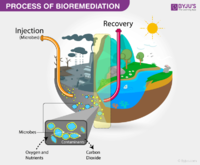
In addition to strategies that could help restore currently operating ecosystems, a number of strategies have been proposed in order to restore currently uninhabited ecosystems. One of these proposals is the addition of biodegradable waste to eroded and polluted landscapes. It is proposed that this would restore the organic content to the depleted soil, increase microbial activity in the soil, and increase the overall biodiversity of microbes found in these soils. [38] While this strategy would require strict guidelines regulating the quality of waste and monitoring ecosystem recovery, this would increase the amount of arable land available while simultaneously restoring biodiversity and constructively disposing of organic waste. Another similar strategy involves the removal of nanoparticles from our environment. Nonylphenols are a group of compounds involved in nanotechnology technologies that exert a highly unstudied amount of environmental impact. [39] However, there are strategies being developed to remove these potentially harmful contaminants. Activated sludge is an aggregate of bacteria and protozoa that can decontaminate aquatic solutions. [39] A 2010 study examined the effectiveness of activated sludge in removing nanoparticles from an aquatic environment and found that to different extents, different contaminants were removed. [40] However, differences in the amount of the substance removed depended on the surface properties of the substance, indicating the importance of microbial diversity in remediation strategies as well. [40] Overall, it is clear that a global cooperative effort is needed to make progress towards environmental remediation. However, there are numerous strategies and new emerging ones that show significant promise in their ability to restore proper functioning to increasingly polluted and changing ecosystems.
Conclusion
Biodiversity is a necessary factor for any healthy ecosystem, as biodiversity maintains genetic variation and therefore alots the ability for ecosystem resilience in the face of changing biotic and abiotic conditions. Microbial biodiversity in particular can exert a profound influence on an ecosystem since microbes can control primary production structure and efficiency, decompose and cycle critical nutrients, and provide numerous specialized symbiotic contributions. [5] [1] Furthermore, there is a limited amount of functional redundancy within microbial communities, indicating the importance of each species and broad biodiversity. [13] Given that increased levels of biodiversity are needed to maintain stable ecosystems under climate change, and the fact that the biosphere is definitively changing, the importance of maintaining and further propagating microbial diversity is as important as it ever has been. [11] [3] New and emerging strategies of bioremediation show promising initial results, and there is a vastly unexplored microbial world that could offer even more promising results. However, in order to realistically combat this issue, an immediate and cooperative global effort is needed.
References
- ↑ 1.0 1.1 van der Heijden, M. G. A., Bardgett, R. D., & van Straalen, N. M. (2008). The unseen majority: Soil microbes as drivers of plant diversity and productivity in terrestrial ecosystems. Ecology Letters, 11(3), 296–310.
- ↑ Martín, R., Miquel, S., Ulmer, J., Langella, P., & Bermúdez-Humarán, L. g. (2014). Gut ecosystem: How microbes help us. Beneficial Microbes, 5(3), 219–233.
- ↑ 3.0 3.1 Estrada, F., Kim, D., & Perron, P. (2021). Anthropogenic influence in observed regional warming trends and the implied social time of emergence. Communications Earth & Environment, 2(1), 1–9.
- ↑ Zardi, G. I., Monsinjon, J. R., McQuaid, C. D., Seuront, L., Orostica, M., Want, A., Firth, L. B., & Nicastro, K. R. (2021). Foul‐weather friends: Modelling thermal stress mitigation by symbiotic endolithic microbes in a changing environment. Global Change Biology, 27(11), 2549–2560.
- ↑ 5.0 5.1 5.2 5.3 Mohanty, S., & Swain, C. K. (2018). Role of microbes in climate smart agriculture. In D. G. Panpatte, Y. K. Jhala, H. N. Shelat, & R. V. Vyas (Eds.), Microorganisms for Green Revolution: Volume 2: Microbes for Sustainable Agro-ecosystem (pp. 129–140). Springer.
- ↑ Enzmann, F., Mayer, F., Rother, M., & Holtmann, D. (2018). Methanogens: Biochemical background and biotechnological applications. AMB Express, 8, 1.
- ↑ Mohanty, S., & Swain, C. K. (2018). Role of microbes in climate smart agriculture. In D. G. Panpatte, Y. K. Jhala, H. N. Shelat, & R. V. Vyas (Eds.), Microorganisms for Green Revolution: Volume 2: Microbes for Sustainable Agro-ecosystem (pp. 129–140). Springer.
- ↑ Mohanty, S., & Swain, C. K. (2018). Role of microbes in climate smart agriculture. In D. G. Panpatte, Y. K. Jhala, H. N. Shelat, & R. V. Vyas (Eds.), Microorganisms for Green Revolution: Volume 2: Microbes for Sustainable Agro-ecosystem (pp. 129–140). Springer.
- ↑ S., & Swain, C. K. (2018). Role of microbes in climate smart agriculture. In D. G. Panpatte, Y. K. Jhala, H. N. Shelat, & R. V. Vyas (Eds.), Microorganisms for Green Revolution: Volume 2: Microbes for Sustainable Agro-ecosystem (pp. 129–140). Springer.
- ↑ Finlay, B. J., Maberly, S. C., & Cooper, J. I. (1997). Microbial diversity and ecosystem function. Oikos, 80(2), 209–213.
- ↑ 11.0 11.1 11.2 García, F. C., Bestion, E., Warfield, R., & Yvon-Durocher, G. (2018). Changes in temperature alter the relationship between biodiversity and ecosystem functioning. Proceedings of the National Academy of Sciences, 115(43), 10989–10994.
- ↑ Bellard, C., Bertelsmeier, C., Leadley, P., Thuiller, W., & Courchamp, F. (2012). Impacts of climate change on the future of biodiversity. Ecology Letters, 15(4), 365–377.
- ↑ 13.0 13.1 13.2 Delgado‐Baquerizo, M., Giaramida, L., Reich, P. B., Khachane, A. N., Hamonts, K., Edwards, C., Lawton, L. A., & Singh, B. K. (2016). Lack of functional redundancy in the relationship between microbial diversity and ecosystem functioning. Journal of Ecology, 104(4), 936–946.
- ↑ Vitorino, L. C., & Bessa, L. A. (2018). Microbial diversity: The gap between the estimated and the known. Diversity, 10(2), 46.
- ↑ 15.0 15.1 Slonczewski, J., Foster, J. W., & Zinser, E. R. (2020). Microbiology: An evolving science (Fifth edition, international student edition). W.W. Norton & Company.
- ↑ Xu, X., Liu, W., Tian, S., Wang, W., Qi, Q., Jiang, P., Gao, X., Li, F., Li, H., & Yu, H. (2018). Petroleum hydrocarbon-degrading bacteria for the remediation of oil pollution under aerobic conditions: A perspective analysis. Frontiers in Microbiology, 9.
- ↑ Raina, J.-B., Eme, L., Pollock, F. J., Spang, A., Archibald, J. M., & Williams, T. A. (2018). Symbiosis in the microbial world: From ecology to genome evolution. Biology Open, 7(2), bio032524.
- ↑ van der Heijden, M. G. A., Bakker, R., Verwaal, J., Scheublin, T. R., Rutten, M., van Logtestijn, R., & Staehelin, C. (2006). Symbiotic bacteria as a determinant of plant community structure and plant productivity in dune grassland. FEMS Microbiology Ecology, 56(2), 178–187.
- ↑ 19.0 19.1 Moreau, C. S. (2020). Symbioses among ants and microbes. Current Opinion in Insect Science, 39, 1–5.
- ↑ U. S epa web server. (n.d.). Retrieved April 15, 2022, from
- ↑ 21.0 21.1 Zhao, B. Q., Li, X. Y., Liu, H., Wang, B. R., Zhu, P., Huang, S. M., Bao, D. J., Li, Y. T., & So, H. B. (2011). Results from long-term fertilizer experiments in China: The risk of groundwater pollution by nitrate. NJAS - Wageningen Journal of Life Sciences, 58(3), 177–183.
- ↑ 22.0 22.1 22.2 Maitra, S., Pramanick, B., Dey, P., Bhadra, P., Shankar, T., & Anand, K. (2021). Thermotolerant soil microbes and their role in mitigation of heat stress in plants. In A. N. Yadav (Ed.), Soil Microbiomes for Sustainable Agriculture: Functional Annotation (pp. 203–242). Springer International Publishing.
- ↑ 23.0 23.1 Aguilar-Paredes, A., Valdés, G., & Nuti, M. (2020). Ecosystem functions of microbial consortia in sustainable agriculture. Agronomy, 10(12), 1902.
- ↑ 24.0 24.1 Herath, L., Seneviratne, G., Jayasinghe, J. W., & Senanayake, D. N. (2017). Microbial biofilms and mitigation of loss of agro-biodiversity in degraded soils. Journal of the National Science Foundation of Sri Lanka, 45(4), 329–335.
- ↑ Panizzon, J. P., Pilz Júnior, H. L., Knaak, N., Ramos, R. C., Ziegler, D. R., & Fiuza, L. M. (2015). Microbial diversity: Relevance and relationship between environmental conservation and human health. Brazilian Archives of Biology and Technology, 58, 137–145.
- ↑ Han, K.-T. (2009). Influence of limitedly visible leafy indoor plants on the psychology, behavior, and health of students at a junior high school in taiwan. Environment and Behavior, 41(5), 658–692.
- ↑ Bloomfield, S. F., Rook, G. A., Scott, E. A., Shanahan, F., Stanwell-Smith, R., & Turner, P. (2016). Time to abandon the hygiene hypothesis: New perspectives on allergic disease, the human microbiome, infectious disease prevention and the role of targeted hygiene. Perspectives in Public Health, 136(4), 213–224.
- ↑ Li, Q., Kobayashi, M., Inagaki, H., Hirata, Y., Li, Y. J., Hirata, K., Shimizu, T., Suzuki, H., Katsumata, M., Wakayama, Y., Kawada, T., Ohira, T., Matsui, N., & Kagawa, T. (2010). A day trip to a forest park increases human natural killer activity and the expression of anti-cancer proteins in male subjects. Journal of Biological Regulators and Homeostatic Agents, 24(2), 157–165.
- ↑ Trinh, P., Zaneveld, J. R., Safranek, S., & Rabinowitz, P. M. (2018). One health relationships between human, animal, and environmental microbiomes: A mini-review. Frontiers in Public Health, 6, 235.
- ↑ Sabine, C. L., Feely, R. A., Gruber, N., Key, R. M., Lee, K., Bullister, J. L., Wanninkhof, R., Wong, C. S., Wallace, D. W. R., Tilbrook, B., Millero, F. J., Peng, T.-H., Kozyr, A., Ono, T., & Rios, A. F. (2004). The oceanic sink for anthropogenic CO2. Science (New York, N.Y.), 305(5682), 367–371.
- ↑ 31.0 31.1 Sandifer, P. A., & Sutton-Grier, A. E. (2014). Connecting stressors, ocean ecosystem services, and human health: Connecting stressors, ocean ecosystem services, and human health. Natural Resources Forum, 38(3), 157–167.
- ↑ 32.0 32.1 Boyero, L., Pearson, R. G., Gessner, M. O., Barmuta, L. A., Ferreira, V., Graça, M. A. S., Dudgeon, D., Boulton, A. J., Callisto, M., Chauvet, E., Helson, J. E., Bruder, A., Albariño, R. J., Yule, C. M., Arunachalam, M., Davies, J. N., Figueroa, R., Flecker, A. S., Ramírez, A., … West, D. C. (2011). A global experiment suggests climate warming will not accelerate litter decomposition in streams but might reduce carbon sequestration: Global patterns of decomposition in streams. Ecology Letters, 14(3), 289–294.
- ↑ Hicks Pries, C. E., Castanha, C., Porras, R. C., & Torn, M. S. (2017). The whole-soil carbon flux in response to warming. Science, 355(6332), 1420–1423.
- ↑ 34.0 34.1 Vicuña, R., & González, B. (2021). The microbial world in a changing environment. Revista Chilena de Historia Natural, 94(1), 2.
- ↑ Rath, K. M., Murphy, D. N., & Rousk, J. (2019). The microbial community size, structure, and process rates along natural gradients of soil salinity. Soil Biology and Biochemistry, 138, 107607.
- ↑ Sowerby, A., Emmett, B., Beier, C., Tietema, A., Peñuelas, J., Estiarte, M., Van Meeteren, M. J. M., Hughes, S., & Freeman, C. (2005). Microbial community changes in heathland soil communities along a geographical gradient: Interaction with climate change manipulations. Soil Biology and Biochemistry, 37(10), 1805–1813.
- ↑ Tang, J., Xu, L., Chen, X., & Hu, S. (2009). Interaction between C4 barnyard grass and C3 upland rice under elevated CO2: Impact of mycorrhizae. Acta Oecologica, 35(2), 227–235.
- ↑ Kacprzak, M., Kupich, I., Jasinska, A., & Fijalkowski, K. (2022). Bio-based waste’ substrates for degraded soil improvement—Advantages and challenges in european context. Energies, 15(1), 385.
- ↑ 39.0 39.1 Ncibi, M. C., Mahjoub, B., Mahjoub, O., & Sillanpää, M. (2017). Remediation of emerging pollutants in contaminated wastewater and aquatic environments: Biomass-based technologies: water. CLEAN - Soil, Air, Water, 45(5), 1700101.
- ↑ 40.0 40.1 Kiser, M. A., Ryu, H., Jang, H., Hristovski, K., & Westerhoff, P. (2010). Biosorption of nanoparticles to heterotrophic wastewater biomass. Water Research, 44(14), 4105–4114.
Authored for BIOL 238 Microbiology, taught by Joan Slonczewski, 2022, Kenyon College
